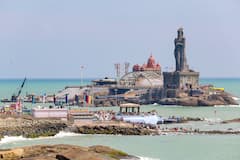Zara To Zudio: How Tata Built A Fashion Empire In India — From Luxury Labels To Affordable Trends
The story of Zara and Zudio goes beyond the brands themselves— it's about how Tata revolutionised the fashion industry and made fashion available to every household.

Ratan Tata was one of India's most influential industrialists who controlled over 30 companies and operated in over 100 countries. Tata's business conglomerate expanded from retail to steel, from clothing lifestyle to IT and construction.
While the world bid a final farewell to Ratan Tata on Thursday, the iconic business leader will be remembered for a unique legacy: despite being a corporate titan, he never appeared on any list of billionaires.
Though Tata's business interests varied from automotive to finance, travel to infrastructure, and telecom to metals, one of the biggest impacts the conglomerate had was the revolution in the country's fashion industry in the country.
ALSO READ | Ratan Tata’s Net Worth: Why Business Tycoon Never Made It To Any Wealthiest People Lists?
Two of Tata's brands have taken the fashion industry by storm: Zara and Zudio. However, the real story goes beyond the brands themselves— it's about how Tata revolutionised the fashion industry and made fashion available to every household.
How Zara Entered India?
The Spanish giant and fast-fashion Zara, that started in the 1970s, is known for its latest designs and is among the top clothing brands. Despite its strategy being zero advertising and investing the revenue in opening stores across the world, the brand has gained popularity among the younger generation.
Though Zara had around 95 stores around the world in 2009 alone, it entered the Indian market in 2010. While international luxury brands like Louis Vuitton, Gucci and Chanel were present in Mumbai and Delhi.
The first decade of the twentieth century saw the boom of the middle class in the country who had high disposable income. It was the time when malls had started to open across cities and global brands were getting exposure through advertisements. In this backdrop, Tata Group's visionary thought led to the entry of Zara into the Indian market.
Tata's leadership ensured that the entry of Zara was not a commercial partnership alone, but rather a cultural one. Zara opened its first store in New Delhi in 2010 and positioned as a global fashion brand with local sensibilities.
The brand catered to the young aspirational audience and made the fashion available to the middle class. In an era, where the fashion industry was fast-changing, Zara ensured access to international trends without going abroad. Today, the clothing brand is one of the biggest fashion retailers in the country and a glaring example of Tata's strategic foresight.
Zara Is Not The Limit
The Tata Group also came up with other clothing brands, including Zudio and Westside, to make fashion more affordable and available. While Westside is positioned for the mid to high-segment audience and catering to more 'mature' audience, Zudio is positioned to cater to mid to low-segment audiences who are more on the younger side.
Despite being a late entrant in the fashion market, Zudio has risen to prominence, becoming a symbol of affordable fashion offering stylish yet budget-friendly apparel. The aim of Zudio to make everything available at a three-digit price is what sets it apart.
ALSO READ | Ratan Tata's Succession: Who Will Lead The Tata Legacy?
This strategy has not only led Zudio to become a household name but also sparked a culture of competition that challenges the accepted price. People go for Zudio since the fashionable outfits are available at affordable rates.
While Zara still has a little larger market share and greater revenue, Zudio has a 15 per cent net profit margin, making it more profitable. Though Zudi was launched in 2016, it has reached 119 cities. Zara, on the other hand, is available in 90 cities.
As Ratan Tata embarks on his final journey, he leaves behind a lasting legacy in the fashion industry— that will continue to inspire future fashion leaders and build the clothing industry into a competitive yet affordable one.
Trending News
Top Headlines








































